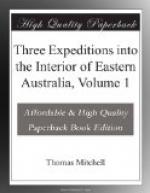ARRIVE AT TANDOGO.
At four o’clock we reached Tandogo, a fine creek of water descending from the south, and flowing to the Bogan.
A hill to the north-west, I was informed, was named the Bugamel.
ALLAN’S WATER OF OXLEY.
April 15.
I halted to lay down my survey, and connect it with that of Mr. Dixon of the Bogan. At noon I found our latitude to be 32 degrees 45 minutes 30 seconds South and on making allowance for the difference between Mr. Oxley’s base (as to longitude) and my own, I supposed we were then upon Allan’s Water of Oxley.
ADVANTAGE OF ABORIGINAL NAMES ON MAPS.
In this instance, as in many others, the great convenience of using native names is obvious. For instance, so long as any of the aborigines can be found in the neighbourhood of Tandogo, future travellers may verify my map. Whereas new names are of no use in this respect, especially when given to rivers or watercourses by travellers who have merely crossed them without ascertaining their course, or even their sources, or termination. He alone should be entitled to give a name to a river who explored its course or, at least, as much of it as may be a useful addition to geography; and when a traveller takes the trouble to determine the true place of hills or other features he might perhaps be at liberty to name them also. The covering a map with names of rivers or hills crossed or passed merely in traversing an unknown country, amounts to little more than saying that so many hills and rivers were seen there; and if nothing were ascertained further of the connections of the former, or the courses of the latter, we derive from such maps little more information than we had before; for that hills and rivers are to be seen in any unknown part of a country is generally understood to be the case before a traveller commences his journey. A future explorer determines with much trouble the position of a river in the world’s map. “This is my river B—–,” says the man who crossed it first, or who, by merely stumbling perhaps upon it, claims all the merit of its DISCOVERY, even when circumstances may have forced him to proceed in that direction, rather than that he was looking for what he found under the guidance of any analogy, or series of observations.
In the afternoon I rode back to the hill of Boorr (seven miles) with the theodolite, and I obtained some useful angles to various points of Harvey’s range, and on such few eminences as could be distinguished in other directions.
EXCURSION WITH MR. CUNNINGHAM.
April 16.
Mr. Larmer went forward with the carts in a north-west direction while I proceeded westward, accompanied by Mr. Cunningham, towards a hill which I had intersected from Mounts Juson and Laidley, and which I expected to find at about nine miles west by compass from our camp.
EFFECTS OF A HURRICANE IN THE FOREST.




